It is a common practice in Hinduism / Hindu Dharma to offer food to the Deities during ritualistic worship or puja at home or temples. This offering is called as Naivedya. It signifies the actual gross state of the individual. Offering Naivedya is the last step in puja. The food items to be offered to each Deity is predetermined. It is said that every Deity has some favourite food item which is offered as Naivedya to Him / Her, for example, kheer or shira for Vishnu, modak for Ganapati, payas for Goddess. The specific food item offered to a specific Deity attracts more frequencies of that respective Deity. After offering the Naivedya, the Deities subtly accept it afterwards this offering is called as Prasad, which is partaken by everyone. When this Naivedya is partaken as prasad, we benefit from the energy of that Deity in it. In this article gives information about spiritual significance of offering Naivedya and various aspects of this act.
1. How to offer Naivedya to the God ?
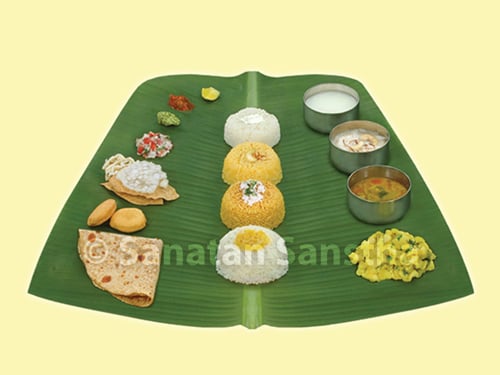
A. While preparing Naivedya, less amount of red chilli powder, salt and oil should be used; sattvik substances such as ghee (Clarified butter) should be used in ample quantity.
B. Banana leaf should be used for offering Naivedya.
C. Salt should not be served on the leaf prepared for Naivedya to a Deity.
D. Keep the leaf (on which the Naivedya has been served) covered.
E. When offering Naivedya, first pray to the Ishtadevata and draw a mandal on the floor in front of the Deity. Then place the banana leaf (or plate) containing Naivedya on this mandal with the stalk of the leaf towards the Deity and the tip of the leaf towards yourself.
F. While offering Naivedya, water should be sprinkled clockwise around the banana leaf or the plate only once (this act is known as drawing a mandal). Water should not be sprinkled anticlockwise again.
G. The act of offering Naivedya to a Deity : Water should be sprinkled on the Naivedya with two tulsi leaves. One leaf should be placed over the Naivedya and the second leaf should be offered at the Deity’s Holy feet. Then, the eyes should be closed by placing the thumb of the left hand on the left eye and the ring finger of the left hand on the right eye. Thereafter, the aroma of Naivedya should be directed towards the Deity using the fingertips of the right hand while reciting mantras associated with the Pancha- pranas (Five vital energies), namely, ‘Om Pranaya Swaha, Om Apanaya Swaha, Om Vyanaya Swaha, Om Udanaya Swaha, Om Samanaya Swaha, Om Brahmane Swaha’.
H. Thereafter, reciting नैवेद्यमध्येपानीयं समर्पयामि । pour little water into the tamhan (Round metal dish) from the right hand, and once again recite the mantra ‘Om Pranaya……’ associated with Panchapranas. Then, reciting ‘नैवेद्यम् समर्पयामि, उत्तरापोशनम् समर्पयामि, हस्त समर्पयामि, मुख समर्पयामि’ water should be released from the right hand into tamhan four times.
I. ‘We should have a bhav that the Naivedya offered is reaching the Deity and the Deity is consuming it.’
J. After offering Naivedya (usually in small quantity), mix it with the rest of the food, so that those who eat this food benefit from it.
2. What should be the bhav of the individual who is offering Naivedya ?
Bhav is important when offering any food item to a Deity. Greater the bhav of the individual offering Naivedya, greater is the possibility of the food being accepted by the Deity. While offering Naivedya, we should have a bhav that the Naivedya being offered by us is reaching the Deity and the Deity is accepting it.
3. What should be offered as Naivedya ?
A. Why should salt not be served in the plate / leaf used for offering Naivedya ?
Salt is associated with Pruthvitattva (Absolute Earth Principle) and apatattva (Absolute Water Principle) and hence, the proportion of Raja -Tama predominant waves attracted to it is greater. Therefore, pinch of salt should not be served in the plate / leaf used for offering Naivedya. However, items prepared using salt can be offered to the Deities.
B. Why are sattvik dishes prepared for Naivedya?
Use minimum quantity of chilli, salt and oil when preparing dishes for Naivedya, since these substances are Raja-Tama predominant. Use more of ghee, since it is sattvik. It makes the other substances sattvik too. Serve as many sattvik dishes as possible in the plate / leaf used for offering Naivedya, since such food items have a greater ability to imbibe the sattvik waves emitting from Deities in the form of blessings.
4. Why should the Naivedya be kept covered before offering it to a Deity?
When covered, the emission of waves from the food items into the atmosphere is controlled.
Explanation: Naivedya items are prepared from sattvik substances, and hence, Naivedya as a whole too becomes sattvik. Generally, the environment in Kaliyug is Raja-Tama predominant. If the Naivedya is left uncovered, there is greater possibility of it becoming Raja-Tama predominant. Hence, it is better to cover the food.
5. When offering Naivedya, how should the banana leaf be placed ?
Naivedya is offered to a Deity on a banana leaf. When compared with the stalk of a banana leaf, its tip has greater ability to emit sattvik waves. sattvik waves emit from the tip of the banana leaf like a fountain. These fountain-like waves help in reducing the proportion of Raja-Tama components in the environment around the individual. Hence, while offering Naivedya to the Deity, the stalk of the leaf on which the Naivedya is served should be towards the Deity and its tip should be towards us.
Arrangement of food items (naivedya) on banana leaf:
The banana leaf with Naivedya shown in the arrangement above symbolises the state of the individual. In the actual arrangement do not place the Naivedya leaf. Offer Naivedya only after puja has been completed. For convenience, before commencing puja, move the platter to the right of the panchapatra and ritualistic spoon.
6. Why are tulsi leaves used while offering Naivedya to a Deity ?
When tulsi leaves are used for offering Naivedya to a Deity, it reaches the Deity faster, Naivedya becomes sattvik and the possibility of attacks due to negative energies reduces.
Characteristic features of tulsi : The tulsi plant has a greater ability to attract sattvikta from the atmosphere and effectively emit it towards the individual. It also has a greater ability to attract the Krushṇatattva in the universe.
Benefits
- By using tulsi leaves for offering Naivedya, the subtle-waves emitting from the sattvik food are imbibed by the leaves. Thereafter, by offering the tulsi leaves enriched with the subtle-waves to the Deity, the Deity Principle is easily able to absorb these waves. In this way, the food offered by us easily reaches the Deity through the medium of tulsi leaves and this helps in pleasing the Deity faster.
- When a tulsi leaf is placed on the Naivedya, the covering of Raja-Tama particles on it reduces. Due to the sattvik waves emitting from the tulsi leaves, the environment around the Naivedya gets purified, and the possibility of attacks by negative energies on the Naivedya reduces.
- When a tulsi leaf is placed on the Naivedya with bhav, due to its inherent qualities the leaf imbibes the Chaitanya emitting from the Deity and effectively transmits it into the Naivedya. Partaking such Naivedya helps the body of the individual to obtain waves of Chaitanya.’
7. How many times water should be sprinkled around the Naivedya ?
While offering Naivedya, sprinkle water around the plate / leaf only once in a clockwise manner (to make a mandal. Do not sprinkle water in an anti-clockwise manner, because this activates the dormant tiryak (Raja-Tama-predominant) waves in the universe and a dynamic sheath of these distressing waves is created around the plate. Due to the waves emitting from this sheath, the Tama component in the praṇamaya-kosha (Vital energy sheath) of the individual increases, which makes it restless.
A. Benefits
Inability of the dissatisfied subtle-bodies and inferior negative energies to consume the Naivedya : ‘When the manaha-shakti of an individual is not awakened adequately while offering Naivedya, due to absence of emission of the collective energy of the individual’s manaha-shakti, the attraction-waves emitting from the food gain momentum in a haphazard manner. The unsatisfied subtle-bodies (that have desire for food) are attracted through the medium of the waves of attraction emitting from the food and they consume the Naivedya. Hence, there is a possibility of the food getting charged with Tama particles. To prevent this, make a mandal with water before offering Naivedya to the Deity. By making a mandal clockwise, the waves of attraction emitting from the food gain momentum within this mandal and start moving in the upward direction due to the cover provided by the upward emission of the apatattva. This makes it difficult for inferior negative energies to consume the food easily.
Reduction in the possible distress caused by negative energies through the medium of food: Waves emitting from the mandal drawn around the plate converge towards the centre below the plate, which activates the unmanifest energy of the associated Deity present in the centre, and are once again emitted into the environment from the centre. This helps in creation of a covering of subtle sattvik waves on the plate. Hence, while eating the food, the distressing waves emitted by negative energies present in the environment are obstructed from spreading into the body through the medium of food. Similarly, due to the sattvik waves emitting from the water, the black covering of Raja-Tama-predominant waves that has formed on the food is also reduced to some extent.
sattvikta (Purity) spreading rapidly in the body: In this way, we get the benefit of eating sattvik food. The subtle air generated from the waves emitting from such sattvik food is imbibed quickly by the cells of the body and the sattvikta generated by the food spreads quickly in the individual’s body.
8. Why should the eyes be closed while offering Naivedya ?
The sight of food leads to a desire to eat it. To avoid this and be able to offer pure Naivedya devoid of any desire to the Deity, eyes should be closed while offering Naivedya to a Deity.
9. Why is Naivedya offered to the Deity from below to the upward direction ?
Sattvik waves of superior Deities are active in the upper strata of the atmosphere. The auspicious ritual of puja is one that involves invoking Deities in the upward direction and materializing the Principles of Deities associated with the Tejtattva. Hence, this process is associated with the sagun (Materialized). The daily puja is an auspicious act and hence, Naivedya is offered to the Deities (Idols or pictures) from below to the upward direction.
Performing actions with the right hand is auspicious and hence, a Deity is invoked with the right hand. The act of taking food to the Deity’s mouth symbolizes devotedly touching the Principle of the Deity and awakening the Deity. It is essential that the medium used for touching the Deity while awakening it should also be sattvik, equally sensitive and symbol of the kriyashakti. That is why, the act of holding a tulsi leaf and taking the hand higher towards the Deity’s mouth is performed. The hand moves in the upward direction and the vibrations of the Deity too are activated at the subtle level to a greater extent in the upper atmosphere. That is why the act of taking the morsel in the upward direction towards the mouth is given precedence. This act is associated with the sagun, meaning, equal importance is given to bhav as well as action. Greater importance is given to action in the inferior sagun, while greater importance is given to bhav in the superior sagun.
10. How does Deity accept the Naivedya ?
First, the Deities activate the akashtattva present in them, because it helps awaken the other Principles. Next, as per the need, Vayutattva and Tejtattva are awakened. Deities accept the Naivedya through the medium of these awakened Principles.
-
When Naivedya is placed in front of the Deity, they accept it through the Vayutattva.
- Since fire is kindled in homa-havan (Fire-sacrifice performed to appease Deities), the Deities accept the Naivedya through the awakened Tejtattva in them. When the Naivedya is accepted by the Deities, due to their subtle touch it gets transformed into prasad (Holy sacrament).
11. The time required by the Deity to accept Naivedya
It takes only a few seconds for the Deity to accept Naivedya.
12. Spiritual experiences regarding Naivedya
A. The taste of halwa (A sweet dish prepared with semolina, sugar and ghee) improving merely by offering it as Naivedya to His Holiness Bhaktaraj Maharaj: ‘On the day of Gurupourṇima (Full moon day of the month of ashadha, also called Vyas Pourṇima) in 1999, we decided to perform Gurupūjan at home and leave for the venue of Gurupourṇima programme by 10.00 a.m. However, since we were in a hurry in the morning, the halwa (Indian sweet) I prepared did not turn out to be good. There was no time to make it again, therefore, we offered the same halwa as Naivedya to the photo of His Holiness Bhaktaraj Maharaj (fondly known as Baba) and performed the puja. Then, my mother offered me some halwa as prasad on my palm. I ate it and said to my mother, ‘The halwa has been prepared well and tastes just like the prasad of ‘Satyanarayaṇ puja’. Hearing this, my mother kept the vessel with the halwa in front of me. Upon tasting the halwa in the vessel, I realised that there was a lot of difference between the halwa as prasad and the halwa in the vessel.’ – Mrs Arati Nadkarni, Ponda, Goa.
Reference : Sanatan Sanstha’s Holy Text on ‘What is the Importance of the Substances used in Ritualistic Worship?‘ and ‘Science underlying worship with five and sixteen substances’

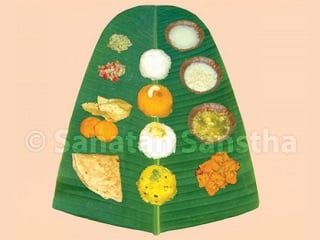
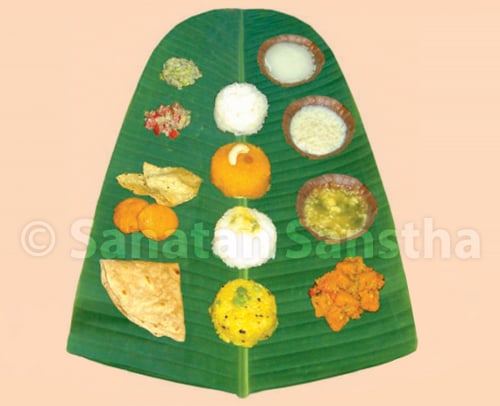
 How to perform Puja Vidhi ?
How to perform Puja Vidhi ? Importance of Puja Samagri in ritualistic worship
Importance of Puja Samagri in ritualistic worship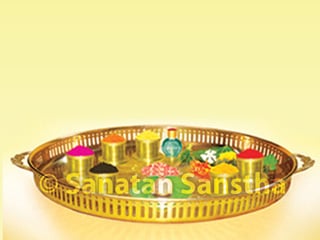 How to arrange the substances in Puja Thali ?
How to arrange the substances in Puja Thali ?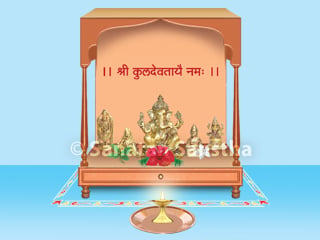 How should be the design of Devghar ?
How should be the design of Devghar ? How to arrange the Puja items used in puja ?
How to arrange the Puja items used in puja ?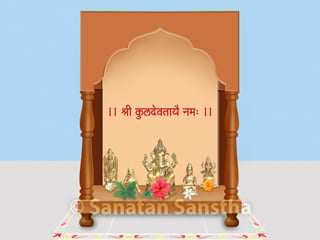 How to arrange Deities in Home temple ?
How to arrange Deities in Home temple ?